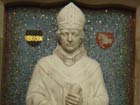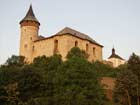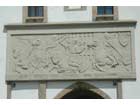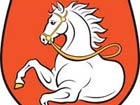History/History/Origins of the city
Origins of the city
The oldest written reference we have to the existence of Pardubice dates back to 1295 and speaks of the local monastery inhabited by the Syriac order at the Church of St. Bartholomew (kostel sv. Bartoloměje). The monks here also cared for another church, the Church of St. Giles (kostel sv. Jiljí) in what is now the suburb of Pardubičky. At that time a lordly manor stood where the chateau now stands. This was built by the important ford over the River Elbe (Labe in Czech), which was also the collection point for duty for floating timber. By this time Pardubice obviously had around one hundred years of history under its belt, something hinted at by later archaeological finds.
Pardubice became a servile town sometime between 1332 and 1340 thanks to its owner at that time, Arnošt of Hostýn. His family later gained an aristocratic title as the Lords of Pardubice. Indeed the town took the coat-of-arms used by Arnošt and his family as its own – the white (silver) front half of a horse with a golden bridle on a red background. The most prominent representative of the family was Arnošt of Pardubice, the first archbishop of Prague, who joined the path of his life to King and Emperor Charles IV. He became his closest advisor and confidante, a prominent diplomat of the time.
Arnošt’s nephew Smil Flaška of Pardubice and Rychmburk won renown as the author of “Nová rada” (New Guidance), a book of verse, allegorical satire of the relations at the court of King Václav IV. Indeed the literary standard of his work influenced a further century of development in Bohemian poetry. Smil, however, lost Pardubice in a court dispute with Václav IV. The new owner was Hanuš of Milheim, a favourite of the king. Hussite devotee Viktorin Boček of Kunštát, father of later king of Bohemia Jiří of Poděbrady, owned Pardubice at the beginning of the Hussite Wars. The city then passed into the hands of Diviš Bořek of Miletínek, who had a new residence built on the nearby hill of Kunětická hora.
The coat-of-arms of the Lords of Pardubice
The Lords of Pardubice have as their coat-of-arms the front half of a horse with a golden bridle on a red background. There is a legend surrounding the origins of this coat-of-arms, which is as follows. Bohemian King Vladislav II set off to Italy in 1158 with Emperor Friedrich Barbarossa to conquer the town of Milan in a war that brought renown to Bohemian warriors for their bravery. During one night time raid they were able to capture the horses and war standard of Milan. However, the people of Milan began to defend the attack and forced the Bohemians out of the town. They released the portcullis just as the last of the warriors was fleeing on his horse. The white horse was cut in two, but still managed to carry its master for a while. The brave squire, named Ješek, took his faithful half horse on his shoulders and carried it all the way to the camp of his king, Vladislav II. As reward for his bravery he was given the front half of the horse as his coat-of-arms. This legend is also depicted on Green Gate (Zelená brána).




